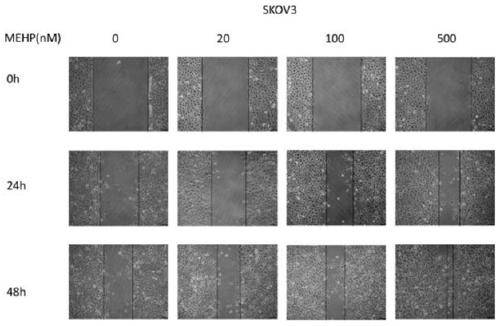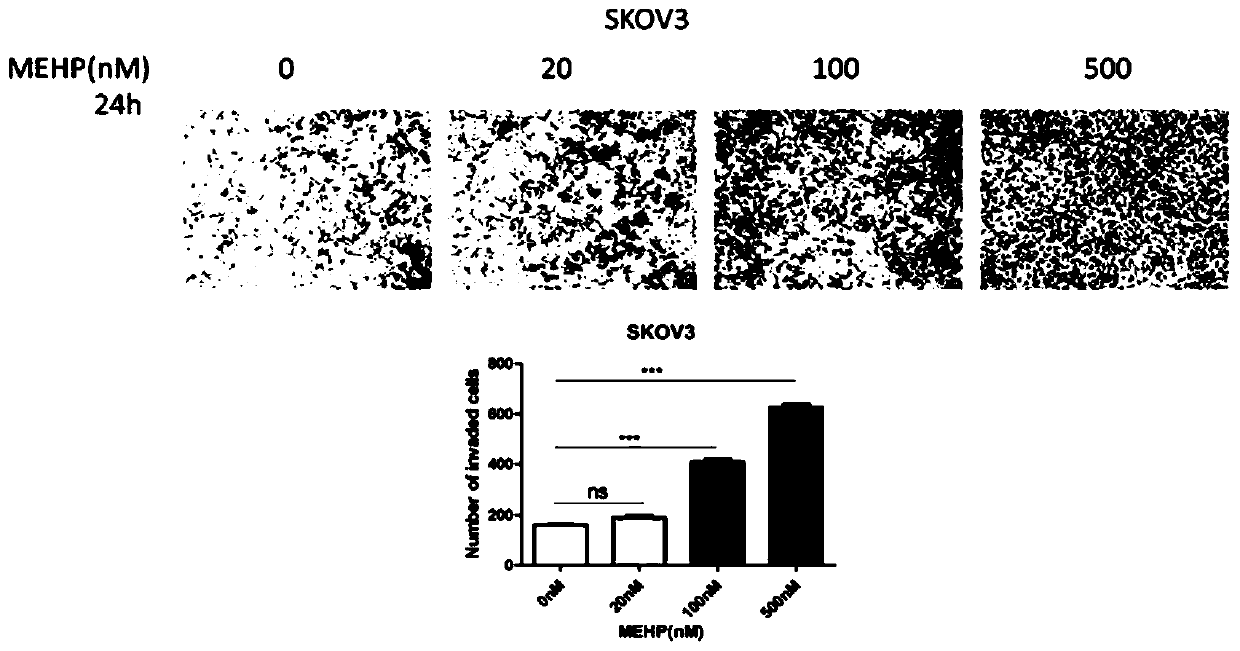Application of long-chain non-coding RNA LINC00205 in preparation of reagent for diagnosing ovarian cancer or medicament for treating ovarian cancer
A long-chain non-coding, ovarian cancer technology, used in biomedicine, the application of long-chain non-coding RNA for tumor suppression
- Summary
- Abstract
- Description
- Claims
- Application Information
AI Technical Summary
Problems solved by technology
Method used
Image
Examples
Embodiment 1
[0033] Example 1. Effect of Nanomolar Dose of MEHP on the Migration and Invasion Ability of Human Ovarian Cancer Cell Lines
[0034]We first explored the effects of low doses of MEHP (0nM, 20nM, 100nM, 500nM) on the migration and invasion of ovarian cancer cells SKOV3 and A2780 in vitro. We found that using 20nM, 100nM or 500nM concentration gradient MEHP (the primary metabolite of DEHP) to treat SKOV3 and A2780 cells for 24 and 48 hours, the healing speed of the scratch area was significantly increased compared with the control group, and the 500nM concentration was used Changes in healing speed are particularly pronounced when treated. Consistent with the results of the scratch healing experiment, compared with the control group, DEHP treatment did not significantly change the invasion ability of SKOV3 and A2780 cells; while MEHP treatment could significantly increase the invasion ability of SKOV3 and A2780 cells. The above experimental results suggest that MEHP and the hyd...
Embodiment 2
[0035] Example 2 MEHP exposure induces epithelial-mesenchymal transition in ovarian cancer cells
[0036] Previous experimental results showed that low doses of MEHP could significantly increase the invasion ability of ovarian cancer cells and promote the metastasis of ovarian cancer cells. The first step of tumor cell invasion and metastasis is EMT. After stimulating SKOV3 and A2780 cells with MEHP (0nM, 20nM, 100nM and 500nM) for 24 hours, we found that both ovarian cancer cell lines underwent EMT. As shown in Figure 2, we used Western blotting to observe the changes of EMT markers. MEHP exposure down-regulated the protein expression of the epithelial marker ZO-1; The protein expression of Slug was up-regulated, and the change of protein expression was most obvious when the concentration of 500nM was used. In addition, we also used immunofluorescence to observe the expression of the interstitial marker Vimentin protein in ovarian cancer cell lines SKOV3 and A2780 cells, and...
Embodiment 3
[0037] Example 3 Changes in the expression of long-chain non-coding RNA after exposure to MEHP
[0038] We observed the expression of lncRNA after MEHP exposure. lncRNAs with a p-value less than 0.05 were defined as differentially expressed genes (DEGs). In the same way as the analysis method of mRNA, we found that compared with the expression of lncRNA in the control group, the expression of a total of 754 lncRNAs in the MEHP exposure group had statistically significant changes, as shown in Figure 3 volcano map and gene heat map, Among the 754 lncRNAs, the expression levels of 695 lncRNAs were up-regulated, and the expression levels of 59 lncRNAs were down-regulated. Among the 754 lncRNAs with differential expression, we screened 39 confirmed lncRNAs and 715 potential lncRNAs. We selected 39 confirmed lncRNAs for further research to explore the relationship between these differentially expressed lncRNAs and the migration, invasion and EMT of ovarian cancer cell lines. As s...
PUM
 Login to View More
Login to View More Abstract
Description
Claims
Application Information
 Login to View More
Login to View More - R&D
- Intellectual Property
- Life Sciences
- Materials
- Tech Scout
- Unparalleled Data Quality
- Higher Quality Content
- 60% Fewer Hallucinations
Browse by: Latest US Patents, China's latest patents, Technical Efficacy Thesaurus, Application Domain, Technology Topic, Popular Technical Reports.
© 2025 PatSnap. All rights reserved.Legal|Privacy policy|Modern Slavery Act Transparency Statement|Sitemap|About US| Contact US: help@patsnap.com



